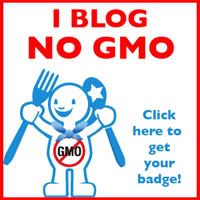This is part of
Real Food Wednesday: Share Your Real Food TestimonialsI was raised to be aware of artificial colors and hydrogenated oils so we didn't get much candy or packaged cookies at home but I never really understood why and you'd better believe that as soon as I hit school, I inhaled the latest kind of every colorful piece I could find. My friends all thought we were health nuts and I guess comparatively, we kind of were, but, oddly enough, we really were not. We had plenty of sugar in our house, we went through many 5lb bags regularly. We ate a lot of cereal and bread, my mom made homemade bread as I got older. We guzzled regular (not organic) skim milk, pasteurized and from cows shot up on growth hormones and living in small confined areas. We ate regular eggs from hens in coops so tight they had their beaks clipped. We used margarine over butter, it was the healthier alternative then. Our meat was mostly kosher so they got a little more room to move but I'm sure they were fed grain, not healthy for cows; I'm not sure if genetic modifications were big back then but as the years passed, I'm sure they were fed gmo corn and soy. The veggies were mostly overcooked, not very delicious, not organic, and we were not encouraged to drink water.
When I moved out on my own I ate whatever without much regard but did pretty much keep away from artificial colors and flavors, out of habit. But my diet wasn't good. And my body felt the effects of it even though I exercised and looked pretty healthy on the outside.

Life changes when you are responsible for someone other than yourself. Pregnant with my first child, my husband and I really started thinking about what I ate to nourish the baby and we started reading and making small changes.
After he started to eat solids, we realized we needed to get into organics and make greater commitments to our health and so our journey into truly real food began. As well as our journey to change how we lived, our footprint on the planet, our understanding for how our purchase impacted others in the world, and to use real products to clean instead of chemicals.
I was just speaking with someone the other day and she asked if I felt healthier. The truth is that we, as a society, don't know how unhealthy we truly are until we change our diet. Then we can feel the difference.
You can tell a lot about a person from their, well, output. Many of us, I was included, thought it was normal to have uncomfortable poops. It's not! Stomach cramps, pains, headaches, constipation, diarrhea, all of this that we live with everyday like it is the way our bodies are meant to work, but it's not. We see commercials on TV to help make these "regular" symptoms tolerable from antacid to laxatives and pain medication because this is our normal. Once we start eating REAL food, we know the truth. But money drives corporations so we are force fed a bunch of convenience pre-packaged foods created with artificial flavorings from fossil fuels and from things that were once food but were raised on sterile farms poisoned with chemicals to enhance our fast-paced life which causes us to need more meds in order to live comfortably.
How has my life changed? I feel alive! I am alive. I have a connection with my food and my family. I take time to create and appreciate each meal (and I usually make three meals a day for the six of us.) My children understand and I have confidence in the choices they make. We make a conscious decision every time we put something in our mouths or make a purchase.

My children taste. When we travel, our biggest luggage is our food. On our way back from Disney World we were running late and hence had run out of food. We stopped at a fast food place (how many of my friends had looked at me like I was a child abuser for never taking them for fast food!) and figured, well, once wouldn't kill them. They had seen the commercials, so you know, happiness comes in a bag. Well, they looked at it and took one bite, spit it out and asked "what is this?" They were right! It really doesn't even taste good. It doesn't taste like real food because it isn't food at all.
My children understand what food is, what it is for, and that it SHOULD taste delicious always. They have respect for the earth, for real food and our connection to the planet. They know that we impact our environment and that each of us must make choices for our own health and the future of our planet. And because they understand, they make good informed choices by themselves. When there is candy at school, they use it to barter for other things their friends have or they give it away. (Really, I actually have had teachers call me to ask if something was wrong because they wouldn't eat the cake, candy or even pizza that was offered.) My children are smart. They know that when they get home they will have some truly yummy food made with real ingredients, including love.

Join the Real Food Wednesday Carnival. Add your testimonial by heading over to
CheeseslaveWhat’s Real Food?
Real food is whole, natural, and nutrient-dense.
* Organic
* Humanely raised (animals on pasture, not in factories)
* Grown locally when possible
* Whole and unrefined (real maple syrup instead of high-fructose corn syrup)
* Processed as little as possible (raw milk instead of pasteurized and homogenized)
* Nutrient-dense (enzymes, vitamins, minerals, and probiotics)
* Free of additives and preservatives
* Free of synthetic and chemical ingredients
* Not genetically modified
* Traditionally produced and prepared
In other words, butter or lard instead of shortening or vegetable oil. Real milk from a cow instead of soy milk. Real sprouted flour (ground fresh or purchased) instead of refined white flour. Real, natural sweeteners like honey or unrefined cane sugar (rapadura or sucanat) instead of white sugar.
If it’s highly processed and/or doesn’t come from nature, it’s not real food!
We’re not saying you have to be perfect (nobody is) but try to feature real foods in your recipes and minimize the junk like vegetable oil and refined sugar and additives.
 We usually get our pots & pans based upon sales or what our mom used for our childhood meals. We don't much think about it again but as we get healthier in what we eat, we start to also look at the tools we use to prepare our healthful meals.
We usually get our pots & pans based upon sales or what our mom used for our childhood meals. We don't much think about it again but as we get healthier in what we eat, we start to also look at the tools we use to prepare our healthful meals. Most cookware on the market is coated with Teflon to make the fat-free cooks happy. Teflon and Silverstone coating is convenient for sticky food and things like eggs, but there are real dangers when not used properly:
Most cookware on the market is coated with Teflon to make the fat-free cooks happy. Teflon and Silverstone coating is convenient for sticky food and things like eggs, but there are real dangers when not used properly: Aluminum is also popular since it is a great conductor of heat and is cheap. Most restaurants use aluminum cookware to prepare food but aluminum is a poison and leaches into our foods (and you'd better believe those aluminum pans used in restaurants are all scratched up so pieces of aluminum are surely in the foods prepared for our enjoyment - which is another reason we tend to not eat out.) Anodized Aluminum does effectively seal the chemicals but harsh chemicals are used to create the anodized aluminum. In addition, it can scratch easily and then you get the aluminum and the black specs (toxic chemicals) into your foods. And it is definitely not dishwasher friendly.
Aluminum is also popular since it is a great conductor of heat and is cheap. Most restaurants use aluminum cookware to prepare food but aluminum is a poison and leaches into our foods (and you'd better believe those aluminum pans used in restaurants are all scratched up so pieces of aluminum are surely in the foods prepared for our enjoyment - which is another reason we tend to not eat out.) Anodized Aluminum does effectively seal the chemicals but harsh chemicals are used to create the anodized aluminum. In addition, it can scratch easily and then you get the aluminum and the black specs (toxic chemicals) into your foods. And it is definitely not dishwasher friendly. Stainless is the most economical choice but is not a good conductor so is always plied with other metals. You can easily scratch it and some of the chromium or nickel may leach into the food, but very minute amount. If a magnet sticks to your stainless steel cookware, it has less nickel and is therefore a safer option.
Stainless is the most economical choice but is not a good conductor so is always plied with other metals. You can easily scratch it and some of the chromium or nickel may leach into the food, but very minute amount. If a magnet sticks to your stainless steel cookware, it has less nickel and is therefore a safer option. Instead choose cast iron (preferably not pre-seasoned and season it yourself that way you know what kind of oil you are using), enameled cast iron, ceramic, glass, or a safe stainless steel cookware.
Instead choose cast iron (preferably not pre-seasoned and season it yourself that way you know what kind of oil you are using), enameled cast iron, ceramic, glass, or a safe stainless steel cookware.






















































